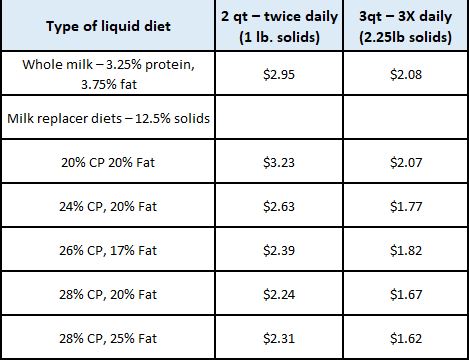What does it “cost” to raise a calf?
Traditionally we have viewed calf rearing as an expensive proposition. Daily costs are high due to feed and labor. Milk and milk replacer are expensive and caring for calves is very labor intensive. To achieve low-cost goals, we have limit-fed milk or milk replacer to encourage early starter intake so that we can wean them at an early age. Weaned calves are much cheaper to feed and care for! Although costs are lower per day does this practice optimize economic returns for the dairy?
Workers are Cornell periodically survey a group of dairies that keep excellent financial records on rearing dairy replacements as shown in the table below. The average replacement herd size was ~1,000 head. Total rearing costs in 2019 ranged from $2,094 to $2,607. Daily costs over the total rearing period averaged $3.45. However daily cost / day for calves less than 200 lb. was almost $6.00! Costs per pound of gain averaged $1.89 with a range of $1.70 to $2.10 over the total rearing period.

Figure 1. Cost per lb of gain at various body size grouping
Karszes, Jason, L. Hill. 2020. Dairy Replacement Program: Cost and Analysis, Summer 2019. ProDairy. Dept of Animal Science and School of Applied Economics and Management. Ithaca, NY.
The purpose of this post is to focus on cost involving the young calf. Several things are apparent from this table. First, although daily costs are highest for this period, they represent only 15.4% of total rearing costs and only 8% of total growth costs. It is important to note that at no period during this animals’ life will their gain be more efficient as feed nutrients are highly digestible. Rather than focus on daily cost we should be looking at what the costs are per unit of performance and in this case that’s growth. Remember that the primary use of nutrients for the calf is to support maintenance and growth. If maintenance costs are barely satisfied, then growth is minimal and the cost for each lb. of gain is high.
The impact of nutrition on cost / unit of gain is demonstrated by the table below which was included in the May/June issue of Dairy Herd Management authored by Dr. Robert Corbett. This table assumed a moderate temperature where environment had less impact on use of nutrients for maintenance.

One could dispute exact costs, but it’s apparent that as nutrient levels increase considering protein and fat in the liquid diet and overall intake, there is more nutrition available for gain and the economic efficiency of growth is enhanced. The challenge with this concept is that we are spending more money now with economic returns that are delayed on not as readily apparent. Research from Cornell University and experiences of progressive dairies has demonstrated that calves that were better fed produced more milk during their first and later lactations. An immediate benefit of enhanced nutrition is that these calves have more nutrient reserves to support better health, meaning lower treatment costs and possibly a lower impact of respiratory disease which can have a permanent impact on later growth and productivity.
How to feed more milk or milk replacer:
· Use of buckets to feed calves allows greater flexibility in delivering nutrients to the calf. This sounds appealing until one considers the challenges of implementing this with hired labor, unless metering devices are used during feeding. Bucket feeding is also more labor intensive, especially if buckets are washed between feedings.
· Bottles are available in 2-, 3- and 4-quart sizes. Bottle filling manifolds and trailers allow more rapid feeding and potentially greater consistency. However, larger bottles are more difficult for workers to handle.

· Feeding frequency. Increasing from twice to three times daily sounds good but is not as effective when all feedings occur within 12 hours. This is especially true with younger calves with more limited digestive capacity. With more equal intervals between feedings are not conducive to labor utilization and satisfaction.
· Free choice acidified systems have been successful on some farms. However, it should be noted that use of formic acid as a preservative is not legal in the US. This system also requires a calf feeder who can manage introduction of calves to the feed due to its lower initial palatability . Weaning can also
be challenging.
· Autofeeders represent the system which most can most nearly replicate the mammalian system of the animal nursing the dam. Smaller, more frequent meals are achieved, and calves can adjust intake with varying environmental conditions. Remember the tables shown above represent calves at a thermoneutral condition of ~ 68 F or 20 C.
Check the following post on the blog! https://calfblog.foerster-technik.com/feeding-plans-ad-lib-vs-restricted/
The dynamics of dairy replacement calf rearing have changed tremendously in the past 10 years. Genomics enable us to enhance selection of better animals. It is increasingly common to breed higher ranking females to dairy sires using sexed semen and lower ranking ones to beef. This usually results in a smaller heifer replacement herd. This system has increased the economic attractiveness of more biologically normal feeding programs for heifer calves. Additionally, sales of surplus heifers from the dairy is no longer an attractive source of profit.
For the most profitable calf rearing program, more milk should be fed. The challenge is how to accomplish this consistently to produce a high quality replacement heifer.


oOjqviwpyxc
sVqCRZypAMgdYDbI